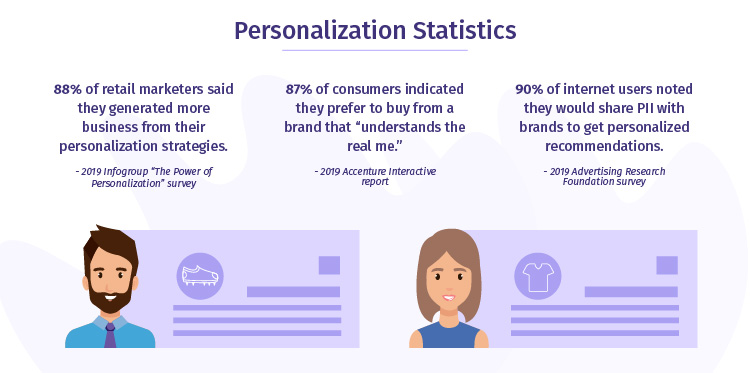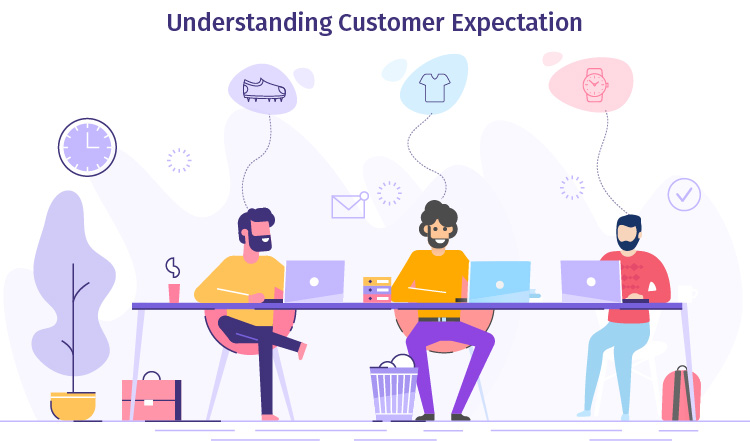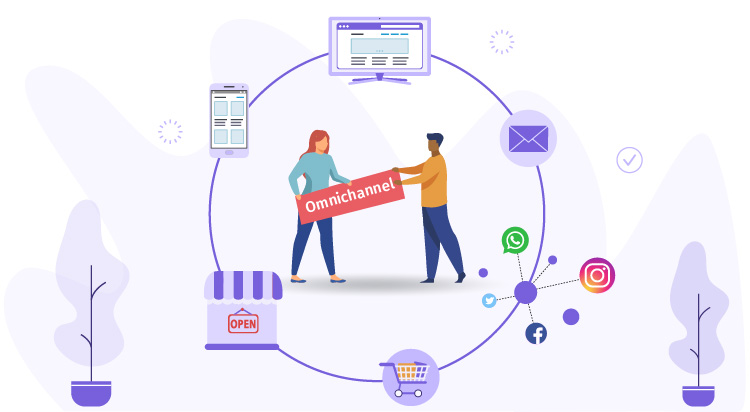Fashion ecommerce is an integral part of our social lives; as more and more consumers are moving to the e-commerce space, online fashion retailers are sure to top the revenue charts in the new normal.
According to Ananth Narayanan, CEO, Myntra-Jabong, “The penetration of online shopping which is currently at 4% will go up to 10 – 15% over the next 3 to 5 years.
However, to make the most of this opportunity, fashion ecommerce brands must be able to cut through the competition by delivering an unmatched customer experience. And to do so, online marketers need to reinvent their strategies with more personalized communication.
A Personalized customer experience here helps to generate more sales in comparison to those who haven’t adopted this strategy. According to a report published by Forbes, 80% consumers are willing to make a purchase from retailers that personalize their buying experience.

Challenges Faced by Online Fashion Ecommerce Retailers
To create a robust online personalization strategy, marketers need to evaluate the roadblocks laid down, and their impact on business flow and consumer behavior. Here are a few industry challenges that marketers need to tackle:
1. Complying with changing consumer preferences
During the pandemic, Amazon’s sales report dropped in apparel sales by an average of 40% while “Indoor” fashion categories, such as loungewear and activewear, fared better.
On the contrary, an online workwear brand Fable Street made face masks in subtle prints and colours to ensemble the work fashion statement.
So, brands need to catch up with the changing needs and preferences of the customer, lest they should be left behind.
2. Disruption in supply chains
A large scale of consumers drifting to online avenues has caused disruption in supply chains as marketers are under constant pressure to keep inventories available according to the rising demand and deliver the shipment on time without causing consequent delays.
3. Embracing safety protocols
Most customers are reluctant to shop due to safety issues with regard to the delivery. Therefore, brands need to comply with the safety and health regulations during the dispatch of the product and ensure that all the warehouse workers and delivery agents are in good health.
According to a report, 64% of consumers want mobile and contactless pickup or check-in options.
Leveraging Personalized Interaction to Amplify Conversions
There has been a drastic shift in consumer buying behavior amidst the COVID era. Unique customer experiences need to be crafted that will persuade buyers to shop more online.
Personalizing online brand messages, recommendations, and offers according to each unique visitor profile enables effective engagement, conversion, and retention of your potential customers online.
Despite possessing a vast pool of data and technologies at their disposal, many marketers end up delivering a poor personalized experience that leaves customers in a shopping dilemma, adding up to their dissatisfaction. As per Smart Insights, 63% of consumers will stop buying from brands that use poor personalization tactics.
Here, the key is to effectively analyzing consumer demographics, interests, and behaviors is to build content and experiences that resonate with the needs of your online audience.

So how do we understand customer expectations after all?
The answer is through the power of meaningful data!
Data is the glue that holds your personalization strategy in place. This data is acquired from various touch points of the user journey like buying habits, intent analysis, shopping appetite, frequency of purchase, etc.
Netcore’s AI engine helps you create and build a hyper-personalized experience driven by the power of data accompanied by AI and ML-based technology to derive maximum online conversions.
Key Steps to Delivering a Personalized Shopping Experience
If you are a marketer who wants to construct a durable ‘Personalization Engine’ for your business, here are the steps to help you get started!
Step 1: Building a buyer persona to identify the target customer
Kick-start by studying the individual data procured to understand the buyer persona. A buyer persona is a research-based user profile that helps identify a target customer. It’s an in-depth description of your potential customers and their requirements.
Buyer persona helps you gauge the buying decisions and challenges that each customer faces. A buyer persona is crucial for every marketer in getting a clear view of their online customers to serve them better.
Step 2: Deploying omnichannel customer engagement strategy
Enable seamless brand experiences through omni-channel customer engagement across multiple platforms like E-mail, Social Media, Mobile Apps, Websites, Ecommerce sites, etc., to deliver a unified customer experience. Customer-centric omnichannel strategies enable brands to retain an average of 89% of their customers, compared to 33% for companies with weak omnichannel customer engagement.

Step 3: Using personalization to deliver customer experience
Once you have collected all the necessary information, it’s time to create personalized messages and recommendations based on data like purchase history, buying frequency, spending appetite, etc.
For instance, Myntra, Ajio, Nykaa, and other fashion ecommerce giants use personalization as the epicenter to build a robust customer experience. They use the transaction and browsing history of each user on the platform, their search pattern, buying behavior and wishlist to determine the fashion preferences of their customers, called the user’s taste profile.
Utilizing Personalized Communication During Festive Sales
Curbing in-store retail offers tremendous scope for online fashion ecommerce retailers to engage and acquire new customers during the festive season. And to leverage this seed of opportunity, marketers have to be prepared with their A-game in personalization. Indian buyers are projected to spend INR 15,000 on average, with a majority surveyed planning to increase their budgets from last year. This is the result of the pent-up savings from the last few months, resulting in a ‘revenge buying’ festive season.
Use personalization to hike up your sales during the festive season by seamlessly
- Promoting crisp and alluring content across platforms.
- Analyzing the user journey and identifying the target prospects.
- Following the digital breadcrumbs to learn the customer expectations.
- Send offers on their last outfit search to seamlessly seal the deal.
- Personalized product recommendations to boost interaction.
- Re-engage with dropped prospects through personalized email or web push notifications.
This way, you will be able to touch base with customers at every point they attempt to buy something, allowing the customers to stay with you till the end whilst deriving complete customer satisfaction.
Final thoughts
Personalization is no more a fad but a future wave in the marketing era. With user preferences constantly changing and increasing demand for better online customer experience, personalization and AI technology are going to be the heart of marketing.
To truly scale your marketing efforts, consider leveraging a robust ecommerce marketing platform. Book a demo today to discover how it can transform your business.
It’s essential that online retailers keep a strong marketing plan in place that delivers a matchless online retail experience making customers return back every time they wish to make a purchase, creating a durable customer and brand relationship virtually.







